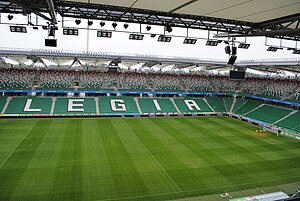Stadion Legii

|
|
| Full name | Stadion Miejski Legii Warszawa im. Marszałka Józefa Piłsudskiego |
|---|---|
| Location | Ulica Łazienkowska 3, 00-449 Warsaw, Poland |
| Owner | City of Warsaw |
| Operator | Legia Warsaw |
| Capacity | 31,800 |
| Record attendance | 30,787 (Legia Warsaw - Śląsk Wrocław, 2 June 2013) |
| Field size | 105 × 68 metres |
| Surface | Grass |
| Construction | |
| Broke ground | 1927 |
| Built | 1927 – 1930 |
| Opened | August 9, 1930 |
| Renovated | 2008 – 2010 |
| Construction cost |
PLN 460 million EUR € 110 million |
| Architect | JSK Architekci |
| Project manager |
Zbigniew Pszczulny Mariusz Rutz |
| Tenants | |
| Legia Warsaw (1927 – ) | |
| Website | |
| Official Website | |
Zbigniew Pszczulny
Marshal Józef Piłsudski Legia Warsaw Municipal Stadium (Polish: Stadion Miejski Legii Warszawa im. Marszałka Józefa Piłsudskiego), traditionally also referred to as the Polish Army Stadium (Polish: Stadion Wojska Polskiego, pronounced [ˌstadjɔn ˌvɔjska pɔlˈskʲɛɡɔ]) in Warsaw, Poland, is an all-seater, highest fourth category football-specific stadium. The venue is located on Łazienkowska street in Śródmieście district. It is the home ground of Legia Warsaw football club, who have been playing there since August 9, 1930.
The stadium underwent a two-stage, complete reconstruction in the years 2008-2011. Only a small part of the main building facade was preserved from the old construction (with another part being precisely reconstructed). With space for 31,103 spectators it is the 5th biggest football stadium in Ekstraklasa and the 7th biggest in the country. The stadium is equipped with a heated pitch, training pitch, underground parking, sport bar, club museum and other facilities.
The stadium, which for decades belonged to the Polish Army, is currently owned by the City of Warsaw.
The necessity to build a new stadium for Legia Warszawa players increased in the mid-1990s, when Legia had one of the most successful periods in its history. Polish championship (Ekstraklasa) (1993 - withdrawn, 1994, 1995), Polish Cup (1995, 1997), semi-final of the UEFA Cup Winners' Cup (1991) and the quarter-final of the UEFA Champions League (1996) strengthened the demand to modernize or even replace the old facility. Ultimately, however, until 1997 virtually nothing on this subject has been done.
...
Wikipedia
